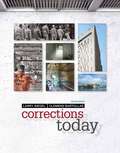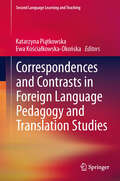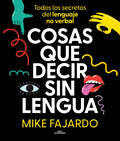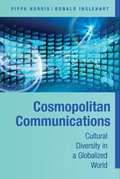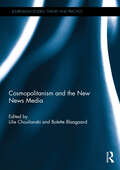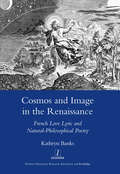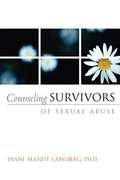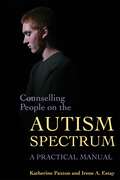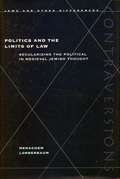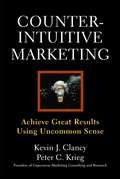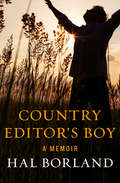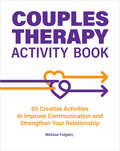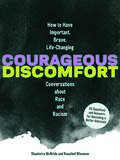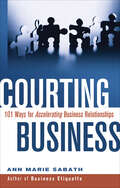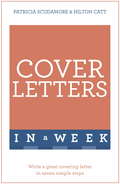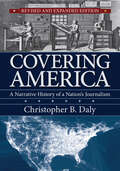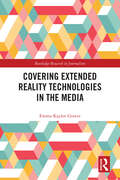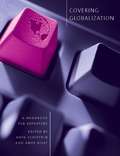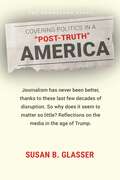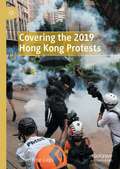- Table View
- List View
Corrections Today
by Larry J. SiegelGet a frontline look at the field of corrections with CORRECTIONS TODAY, 4th Edition. This briefer, visual, paperback alternative to hardback Introduction to Corrections texts is ideal for readers who are interested in real-world concepts and applications. It examines the field of corrections through the lens of students -- perhaps like you -- who are giving serious thought to a career in the field or are working in corrections while seeking an advanced degree in order to be promoted or switch job paths. Updated with new professional profiles and insightful coverage of restorative justice, special offender populations, the use of private prisons, and many other timely topics, the fourth edition offers a practical, engaging, career-focused, and authoritative introduction to corrections.
Correspondences and Contrasts in Foreign Language Pedagogy and Translation Studies (Second Language Learning and Teaching)
by Ewa Kościałkowska-Okońska Katarzyna PiątkowskaThe book constitutes a selection of 18 papers on foreign language pedagogy (11 papers) and translation studies (9 papers). The first part of the book is devoted to foreign language pedagogy. The articles in this part focus on issues such as English as lingua franca, foreign language teacher training, the role of individual learner differences in language learning and teaching especially with respect to strategies of language learning as well as psychological and socioaffective factors. The part focusing on translation studies comprises articles devoted to a variety of topics. It places a wide range of readings within the context of varying translation domains such as translation competence, literary translation, translation strategies, translation teaching (including strategies of dictionary use) and translator training. The combination of the above aspects intends to underline the truly interdisciplinary nature of translation.
Corruption Networks: Concepts and Applications (Understanding Complex Systems)
by Oscar M. Granados José R. Nicolás-CarlockThis book aims to gather the insight of leading experts on corruption and anti-corruption studies working at the scientific frontier of this phenomenon using the multidisciplinary tools of data and network science, in order to present current theoretical, empirical, and operational efforts being performed in order to curb this problem. The research results strengthen the importance of evidence-based approaches in the fight against corruption in all its forms, and foster the discussion about the best ways to convert the obtained knowledge into public policy.The contributed chapters provide comprehensive and multidisciplinary approaches to handle the non-trivial structural and dynamical aspects that characterize the modern social, economic, political and technological systems where corruption takes place.This book will serve a broad multi-disciplinary audience from natural to social scientists, applied mathematicians, including law and policymakers.
Cosas que decir sin lengua: Todos los secretos del lenguaje no verbal
by Mike FajardoMike Fajardo te enseña un montón de curiosidades y trucos sobre la comunicación no verbal para que aprendas a interpretar qué dice la gente cuando no abre la boca. ¿Sabes detectar si una persona está mintiendo? ¿Qué significa que alguien te frunza el ceño? ¿Crees que puedes saber si eres bienvenido en un lugar por la posición de los pies de las personas que te reciben? Y, sobre todo, ¿hay manera de saber, sin preguntarlo, si a esa persona que tanto te gusta también le gustas tú?A partir de ahora, los gestos y los guiños ya no tendrán secretos para ti. En estas páginas encontrarás explicaciones sencillas a por qué cruzamos las piernas en una conversación, los trucos para hablar en público, las técnicas para adelantarnos a los movimientos de los demás y, por supuesto, las claves básicas para interpretar si le gustamos a esa persona.
Cosmopolitan Communications: Cultural Diversity in a Globalized World
by Pippa Norris Ronald InglehartSocieties around the world have experienced a flood of information from diverse channels originating beyond local communities and even national borders, transmitted through the rapid expansion of cosmopolitan communications. For more than half a century, conventional interpretations, Norris and Inglehart argue, have commonly exaggerated the potential threats arising from this process. A series of fire-walls protect national cultures. This book develops a new theoretical framework for understanding cosmopolitan communications and uses it to identify the conditions under which global communications are most likely to endanger cultural diversity. The authors analyze empirical evidence from both the societal level and the individual level, examining the outlook and beliefs of people in a wide range of societies. The study draws on evidence from the World Values Survey, covering 90 societies in all major regions worldwide from 1981 to 2007. The conclusion considers the implications of their findings for cultural policies.
Cosmopolitanism and the New News Media (ISSN)
by Lilie Chouliaraki Bolette BlaagaardThe Arab Spring, the Occupy Wall Street movement and the Haiti earthquake are only some of the recent examples of the power of new media to transform journalism. Some celebrate this power as a new cosmopolitanism that challenges the traditional boundaries of foreign reporting, yet others fear that the new media simply reproduce old power relations in new ways. It is this important controversy around the role of new media in shaping a cosmopolitan journalism that offers the starting point of this book. By bringing together an impressive range of leading theorists in the field of journalism and media studies, this collection insightfully explores how Twitter, Facebook, Flickr and YouTube are taking the voice of ordinary citizens into the forefront of mainstream journalism and how, in so doing, they give shape to new public conceptions of authenticity and solidarity. This collection is directed towards a readership of students and scholars in media and communications, digital and information studies, journalism, sociology as well as other social sciences that engage with the role of new media in shaping contemporary social life. This book was originally published as a special issue of Journalism Studies.
Cosmos and Image in the Renaissance: French Love Lyric and Natural-philosophical Poetry
by Kathryn BanksRenaissance images could be real as well as linguistic. Human beings were often believed to be an image of the cosmos, and the sun an image of God. Kathryn Banks explores the implications of this for poetic language and argues that linguistic images were a powerful tool for rethinking cosmic conceptions. She reassesses the role of natural-philosophical poetry in France, focusing upon its most well-known and widely-read exponent, Guillaume de Saluste Du Bartas.Through a sustained analysis of Maurice Sceve's Delie , Banks also rethinks love lyric's oft-noted use of the beloved as image of the poet. Cosmos and Image makes an original contribution to our understanding of Renaissance thinking about the cosmic, the human, and the divine. It also proposes a mode of reading other Renaissance texts, and reflects at length upon the relation of 'literature' to history, to the history of science, and to political turmoil.
Counseling Survivors of Sexual Abuse (AACC Counseling Library)
by Diane Mandt LangbergThis powerful book deals with the issue of how Christians, especially those called to counsel, can help survivors of sexual abuse find healing and hope. From 20 years of experience, the author demonstrates how counselors can walk alongside people deeply wounded by sexual abuse as they face the truth about who they are, who their abuser was, and who God is as the Savior and Redeemer of all life. Counseling Survivors of Sexual Abuse issues a strong call to the church at large to walk with survivors through the long dark nights of their healing.
Counselling People on the Autism Spectrum: A Practical Manual
by Katherine Paxton Irene EstayThe characteristics of autism spectrum disorders (ASD) present unique challenges, not only to people themselves affected, but also to counselling professionals. This manual provides counselling techniques that work not only for professionals, but also for individuals either coping with being on the spectrum themselves, or living with someone who has an ASD. Regardless of intellectual and linguistic ability, people on the autism spectrum often have significant impairments in emotional expression, regulation, and recognition, and they are known to have higher rates of depression and anxiety than the general population. This comprehensive book shows how to develop the tools necessary to help people on the spectrum cope with their emotions, anxieties, and confusion about the often overwhelming world that surrounds them. Illustrated with useful case studies, it covers a range situations where counselling may be helpful for individuals with ASD, both children and adults, families where a member is on the spectrum, and couples where a partner has ASD. It also addresses specific issues, including depression, anxiety, emotional regulation, social skills, and stress, with effective strategies for dealing with each issue. As well as being indispensable for counsellors, this book provides valuable information and advice for anyone working with people and families affected by ASDs.
Counterculture Colophon: Grove Press, the Evergreen Review, and the Incorporation of the Avant-Garde
by Loren GlassResponsible for such landmark publications asLady Chatterley's Lover,Tropic of Cancer,Naked Lunch, Waiting for Godot,The Wretched of the Earth, andThe Autobiography of Malcolm X, Grove Press was the most innovative publisher of the postwar era. Counterculture Colophontells the story of how the press and its house journal,The Evergreen Review, revolutionized the publishing industry and radicalized the reading habits of the "paperback generation. " In the process, it offers a new window onto the 1960s, from 1951, when Barney Rosset purchased the fledgling press for $3,000, to 1970, when the multimedia corporation into which he had built the company was crippled by a strike and feminist takeover. Grove Press was not only responsible for ending censorship of the printed word in the United States but also for bringing avant-garde literature, especially drama, into the cultural mainstream as part of the quality paperback revolution. Much of this happened thanks to Rosset, whose charismatic leadership was crucial to Grove's success. With chapters covering world literature and the Latin American boom, including Grove's close association with UNESCO and the rise of cultural diplomacy; experimental drama such as the theater of the absurd, the Living Theater, and the political epics of Bertolt Brecht; pornography and obscenity, including the landmark publication of the complete work of the Marquis de Sade; revolutionary writing, featuring Rosset's daring pursuit of the Bolivian journals of Che Guevara; and underground film, including the innovative development of the pocket filmscript, Loren Glass covers the full spectrum of Grove's remarkable achievement as a communications center of the counterculture.
Counterintuitive Marketing: Achieving Great Results Using Common Sense
by Kevin J. Clancy Peter C. KriegWhy does American business seem to sputter along where it ought to thrive? What is the source of the current plague of downsizing, disappearing companies, dot-com crashes, and here-today-gone-tomorrow advertising campaigns? Why do more products flop than ever before? Marketing experts Kevin J. Clancy and Peter C. Krieg have the answers. In Counterintuitive Marketing, Clancy and Krieg trace the high rate of business failure back to bad marketing strategy, and the even worse implementation of that strategy. Excess testosterone, they argue, compels senior managers to make decisions intuitively, instinctively, quickly, and, unfortunately, disastrously. In this informative and enlightening book, Clancy and Krieg confront these "over-and-over-again" marketers, who don't have time to do it right the first time, but endless time and a company bankroll to do it wrong over and over again. The authors draw from their decades of consumer and business-to-business marketing experience to describe the intuitive decision-making practices that permeate business today, and demonstrate how these practices lead to disappointing performance. Chapter by chapter, Counterintuitive Marketing contrasts how marketing decisions are made today with how they should be made. The authors give equal treatment to targeting, positioning, product development, pricing, customer service, e-commerce, marketing planning, implementation, and more as they present counterintuitive ideas for building and introducing blockbuster marketing programs. Readers will discover in this iconoclastic treasure chest hundreds of penetrating insights that have enabled the authors' firm, Copernicus, to transform companies and become a "brand guardian" to the Fortune 500 and emerging businesses around the world. The tools to create exceptional marketing programs really do exist, and they are all here in Counterintuitive Marketing, the ultimate practical guide for any company of any size.
Country Editor's Boy: A Memoir
by Hal BorlandA memoir of youthful years spent in Colorado as the American West was transformed, by the author of High, Wide, and Lonesome and The Dog Who Came to Stay. Country Editor&’s Boy picks up where Hal Borland&’s classic memoir High, Wide and Lonesome left off: with Borland, on the cusp of adulthood in the early twentieth century, making his way in an eastern Colorado town that still retained all the flavors of the Old West. Borland&’s father, the editor of a local weekly newspaper, was working to help his publication transition along with the town around him. At the same time, young Hal was experiencing dramatic social and economic change in his own way. In a matter of a decade, Borland&’s Colorado town shifted from a frontier outpost to part of a rapidly urbanizing new America. This memoir shows a boy entering adulthood as the world around him comes of age. Evocative and wholly engrossing, Country Editor&’s Boy is a vividly drawn portrait of western life, by one of the greatest naturalist writers of his age.
Coupled Structures for Microwave Sensing (Lecture Notes in Electrical Engineering #1150)
by Ferran Martín Enrique BronchaloThis book offers a comprehensive and timely review of planar microwave sensors based on coupled structures. Gathering chapters contributed by the most authoritative researchers on this topic, it presents various strategies for sensor performance optimization using coupled lines, directional couplers, and coupled resonators (either distributed or semi-lumped), focusing mainly on sensitivity optimization, and covering chains of coupled resonators as well. The book also reports on analytical methods, design formulas, sensor validation tests, with both simulation and experimental methods, describing some relevant practical applications. Mainly reflecting the research activity carried out by the different contributors in the last years, this book also includes two introductory chapters to help readers who are not very familiar with microwave sensing technologies and coupled structures. All in all, this book addresses advanced graduate students and researchers involved in microwave and sensor technologies, and may be of interest for engineers and professionals as well, working in areas as diverse as wireless sensors and sensor networks, biosensing, chemical sensing, motion control, microfluidics, Internet of Things (IoT), and smart systems.
Couples Therapy Activity Book: 65 Creative Activities to Improve Communication and Strengthen Your Relationship
by Melissa Fulgieri LCSWStrengthen your relationship with therapy activities for couples Relationships take time and effort to thrive, whether you've been together for four months or 40 years. Foster a deeper bond and work through relationship challenges—together—with this activity book for couples. You'll find a variety of therapeutic activities to help you and your partner build a strong foundation of trust, intimacy, and understanding. Evidence-based techniques—Connect and communicate through proven therapy strategies that support you and your partner as you navigate your relationship. Meaningful themes—Define what love means to you and your partner, embrace vulnerability, resolve conflict, show appreciation for the small things, set goals for the future, and more. Simple, engaging activities—Explore bonding activities like creating a love manual, playing bucket list bingo, and mixing up a cocktail (or mocktail) that represents your partner. Discover how to make your relationship flourish with this top choice in couples therapy workbooks.
Courageous Discomfort: How to Have Important, Brave, Life-Changing Conversations about Race and Racism
by Rosalind Wiseman Shanterra McBrideAn empowering handbook on how to have candid conversations around race and become a better advocate, written by a Black woman and a white woman who ask and answer 20 common, uncomfortable-but-critical questions about racism.Many people struggle to have honest conversations about race, even those who consider themselves allies or identify as anti-racist. For anyone who wants to have better, more productive discussions, COURAGEOUS DISCOMFORT is an empowering handbook that teaches you how to do just that.In these pages, authors (and best friends), Shanterra McBride, who is Black, and Rosalind Wiseman, who is white, discuss their own friendship and tap into their decades of anti-racism work to answer the 20 uncomfortable-but-critical questions about race they get asked most often, including:• Should I see color?• I'm a good person—how can I be racist?• What if I say something wrong?• What kind of apology makes a difference?These 20 questions-as-chapters invite you into the conversation without judgment and inspire thoughtful reflection and discussion. There will be moments when you will laugh or cringe at the ridiculous or awkward things you read. But the truth is, there is no perfect solution or script for every maybe-racist, sort-of-racist, or blatantly racist situation. And that's OK: making mistakes is just an opportunity to do better next time. But doing this work will empower us to have the relationships we really want to have, including the relationship we want to have with ourselves.TIMELY BUT PERENNIAL TOPIC: Social justice is a longstanding, perennial issue but has entered the vanguard of national discourse in recent years. For anyone hungry for resources related to being an advocate for diversity and inclusion, COURAGEOUS DISCOMFORT provides an accessible, empowering playbook to follow as you confront and reckon with race-related issues and questions, now and moving forward.ACCESSIBLE APPROACH: This beautifully designed book stands out from the more academic books in this category like WHITE FRAGILITY and HOW TO BE AN ANTIRACIST. With accessible writing, an organizing principle that invites you into the conversation, and a lovely package, COURAGEOUS DISCOMFORT is user-friendly and can even be given as an inoffensive, helpful gift to friends, relatives, and recent grads.BLACK AUTHOR + WHITE AUTHOR: Written by a Black and white author pair who have both published books before, this handbook is authentic and credible, but also approachable. The authors' tone and the organization of the book make it feel as if you are part of their candid conversation on race, with someone asking all the uncomfortable, awkward questions that you have asked yourself, or your friends are too scared to ask of you. This Q&A format applies to readers, whether they identify as white or non-white, who have found themselves in similar conversations, unsure of how to handle them.GREAT FOR BOOK CLUBS: Inspired by a webinar, featuring chapters-as-questions, this book is primed for book clubs. The organization lends itself perfectly to discussion—clubs can pose each question/chapter title, review the thought prompts, and share personal experiences for an enlightening, educational, and productive conversation.Perfect for:• People who want to have better, more productive conversations around race and racial issues• White people who want to be better allies• Anyone who is focused on social justice, particularly millennials and members of Gen Z• People who read books like WHITE FRAGILITY, CASTE, and HOW TO BE AN ANTIRACIST
Courting Business: 101 Ways for Accelerating Business Relationships
by Ann Marie SabathWhy waste your time chasing after prospects when you can get them to come to you?Most self-proclaimed rainmakers let business drizzle in rather than positioning themselves to experience a downpour. Courting Business gives you the strategies for getting prospects to contact you. Ann Marie Sabath's proven three-step strategy will inspire you to be creative, consistent, and politely relentless in a way that will please even the toughest prospects. This hands-on guide offers tips and techniques for successfully attracting and closing business.With Courting Business, you'll: •Discover the three most important qualities for success.•See why if you're on time, you're late!•Realize how instilling the sense of urgency in your professional style will differentiate you from your competition.•Learn why doing more for fewer people will assist you in developing stronger relationships.•Establish instant rapport with prospects and clients through the use of connectors.•Learn how to overcome the fear of rejection.•Figure out how to turn a "no" today into a "yes" tomorrow.•And much more!
Cover Letters In A Week: Write A Great Covering Letter In Seven Simple Steps
by Pat Scudamore Hilton CattSunday: Understand the importance of first impressions and the common mistakes people make Monday: Ensure your application is taken seriously with a cover letter that is concise, complements your CV and is targeted to the job you have applied for Tuesday: Discover how to style and structure your cover letter with advice on forms of address, etiquette, fonts, margins and the importance of 'white space' Wednesday: Design your cover letter to engage your audience and overcome the competition for advertised jobs Thursday: Design a speculative cover letter to approach the invisible job market Friday: Learn how to address cover letters to agencies and recruitment consultants Saturday: Learn from your applications, whether successful or not, and develop your writing style for the future
Covering America: A Narrative History Of A Nation's Journalism
by Christopher B. DalyJournalism is in crisis, with traditional sources of news under siege, a sputtering business model, a resurgence of partisanship, and a persistent expectation that information should be free. In Covering America, Christopher B. Daly places the current crisis within historical context, showing how it is only the latest challenge for journalists to overcome. <p><p> In this revised and expanded edition, Daly updates his narrative with new stories about legacy media like the New York Times and the Washington Post, and the digital natives like the Huffington Post and Buzzfeed. A new final chapter extends the study of the business crisis facing journalism by examining the "platform revolution" in media, showing how Facebook, Twitter, and other social media are disrupting the traditional systems of delivering journalism to the public. In an era when the factual basis of news is contested and when the government calls journalists "the enemy of the American people" or "the opposition party," Covering America brings history to bear on the vital issues of our times.
Covering America: A Narrative History of a Nation's Journalism
by Christopher B. DalyToday many believe that American journalism is in crisis, with traditional sources of news under siege from a failing business model, a resurgence of partisanship, and a growing expectation that all information ought to be free. In Covering America, Christopher B. Daly places the current crisis within a much broader historical context, showing how it is only the latest in a series of transitions that have required journalists to devise new ways of plying their trade. Drawing on original research and synthesizing the latest scholarship, Daly traces the evolution of journalism in America from the early 1700s to the "digital revolution" of today. Analyzing the news business as a business, he identifies five major periods of journalism history, each marked by a different response to the recurrent conflicts that arise when a vital cultural institution is housed in a major private industry. Throughout his narrative history Daly captures the ethos of journalism with engaging anecdotes, biographical portraits of key figures, and illuminating accounts of the coverage of major news events as well as the mundane realities of day-to-day reporting.
Covering Extended Reality Technologies in the Media (Routledge Research in Journalism)
by Emma Kaylee GravesThis book presents a study of the news coverage of extended reality technologies (virtual, augmented and mixed reality; or XR) and how this news corresponds with the marketing of XR products. Focusing on a group of recently emerging technological products, the book offers in-depth analysis of the news coverage of XR technologies and explores the overlap between news discourse and promotional discourse by comparing the way these products are framed in the news and their marketing materials. Using both quantitative and qualitative data, it discusses the topics covered in XR news, as well as the sources used and the specific framing techniques that appear in both XR news and marketing materials. In addition to these findings, it also provides a set of frame categories that can be used by other researchers analysing the media coverage of emerging technologies. Ultimately arguing that the news represents XR in such a way that treats readers as consumers instead of citizens, prioritising the interests of XR companies rather than news audiences, this book will be of interest to students and researchers in media and communications, discourse studies, journalism, PR and marketing and innovation studies, as well as XR practitioners.
Covering Globalization: A Handbook for Reporters
by Amer Bisat Schiffrin AnyaThe first journalism textbook for reporters who cover finance and economics in developing and transitional countries, Covering Globalization is an essential guide to the pressing topics of our times. Written by economists from the Asian Development Bank and the International Monetary Fund as well as journalists who have worked for Dow Jones, the Financial Times, the New York Times, Fortune, and Reuters--and with an introduction by Nobel Laureate Joseph E. Stiglitz--this invaluable resource helps reporters write about subjects such as banking and banking crises, pension reform, privatization, trade agreements, central banks, the World Bank, sovereign debt restructuring, commodity markets, corporate governance, poverty-eradication programs, and the "resource curse." Each chapter explains the basic economic principles and current thinking on a given topic and provides tips on what to look for when covering specific subjects; a way to structure business and economics stories; a way to use the Internet for reporting with links to more information online; extensive glossaries and much more.
Covering Globalization: A Handbook for Reporters
by Amer Bisat Schiffrin Anya Eds.The first journalism textbook for reporters who cover finance and economics in developing and transitional countries, Covering Globalization is an essential guide to the pressing topics of our times. Written by economists from the Asian Development Bank and the International Monetary Fund as well as journalists who have worked for Dow Jones, the Financial Times, the New York Times, Fortune, and Reuters—and with an introduction by Nobel Laureate Joseph E. Stiglitz—this invaluable resource helps reporters write about subjects such as banking and banking crises, pension reform, privatization, trade agreements, central banks, the World Bank, sovereign debt restructuring, commodity markets, corporate governance, poverty-eradication programs, and the "resource curse." Each chapter explains the basic economic principles and current thinking on a given topic and provides tips on what to look for when covering specific subjects; a way to structure business and economics stories; a way to use the Internet for reporting with links to more information online; extensive glossaries and much more.
Covering Politics in a "Post-Truth" America
by Susan B. GlasserIn a new Brookings Essay, Politico editor Susan Glasser chronicles how political reporting has changed over the course of her career and reflects on the state of independent journalism after the 2016 election.The Bookings Essay: In the spirit of its commitment to higquality, independent research, the Brookings Institution has commissioned works on major topics of public policy by distinguished authors, including Brookings scholars. The Brookings Essay is a multi-platform product aimed to engage readers in open dialogue and debate. The views expressed, however, are solely those of the author. Available in ebook only.
Covering Politics in the Age of Trump
by Jerry CepposLike politics, journalism has been turned topsy-turvy by the presidency of Donald Trump. Covering Politics in the Age of Trump takes a wide-ranging view of the relationship between the forty-fifth president and the Fourth Estate. In concise, illuminating, and often personal essays, twenty-four top journalists address topics such as growing concerns about political bias and journalistic objectivity; increasing consternation about the media’s use of anonymous sources; the practices journalists employ to gain access to wary administration officials; and reporters’ efforts to improve journalism in an era of twenty-four-hour cable news. Contributors include: Mark Ballard, Peter Bhatia, Rebecca Buck, Carl Cannon, Jill Colvin, Charlie Cook, McKay Coppins, Mary C. Curtis, Paul Farhi, Quint Forgey, Major Garrett, Ginger Gibson, “Fin” Gomez, Jesse J. Holland, Clark Hoyt, Sarah Isgur, Mark Leibovich, Ashley Parker, Fernando Pizarro, Tom Rosenstiel, Frank Sesno, Alexis Simendinger, Steve Thomma, and Salena Zito.The Trump administration’s contentious relationship with the media has altered the public’s expectations regarding the news and national politics. In Covering Politics in the Age of Trump, top political reporters explore this dynamic, relaying stories from the campaign trail to the briefing room that illustrate the new challenges faced by journalists working in the age of “fake news.”
Covering the 2019 Hong Kong Protests
by Luwei Rose LuqiuThis book explores the impact of governmental, institutional, and individual factors on journalists covering protests, using the 2019 Hong Kong Anti-Extradition Bill Movement as a case study. The discussion surveys the challenges frontline journalists have faced while covering protests that unfolded in complex and rapidly evolving geopolitical contexts and media ecologies. Complementing this is an analysis of the Chinese government’s efforts to suppress social movements by curtailing press freedom to silence criticism of the government and keep information about the protest efforts from the public. Separate chapters explore these issues from the perspectives of the citizen journalists, student journalists, and independent journalists who have played key roles in the most recent social movements in Hong Kong. It concludes with a look at the future of press freedom in the city after the passage of the National Security Law.
